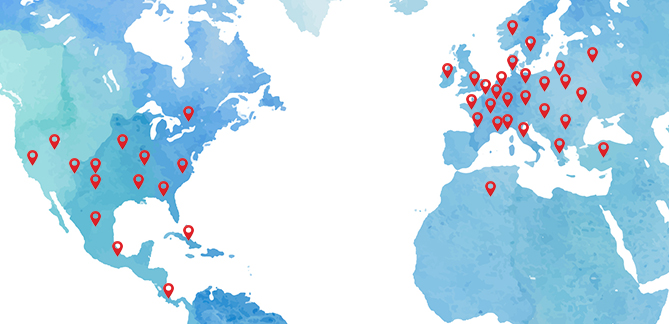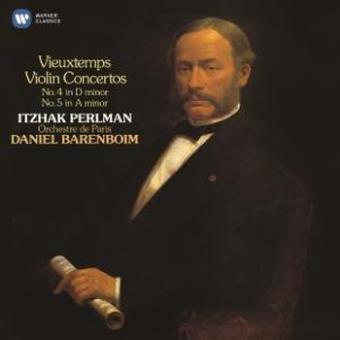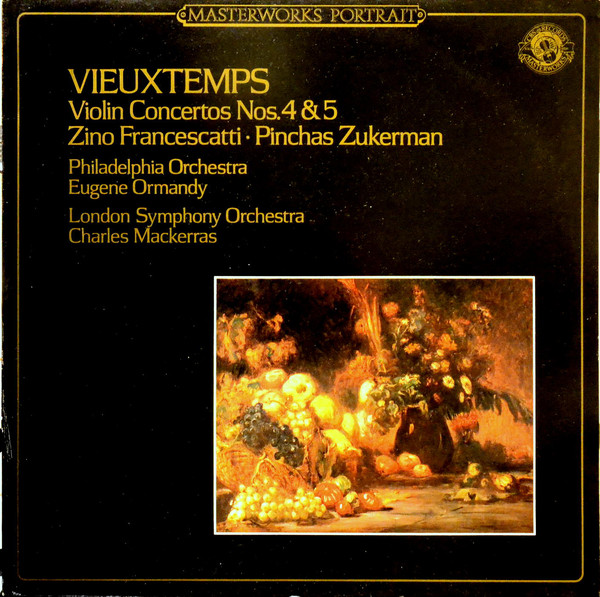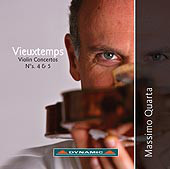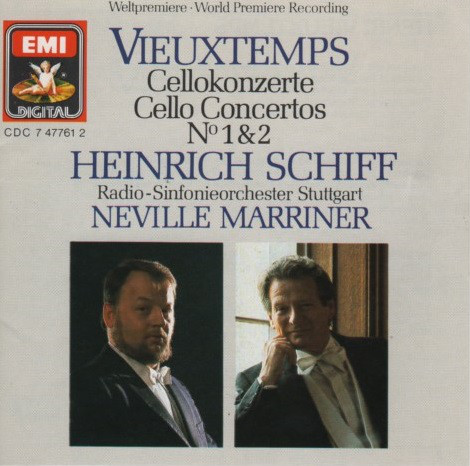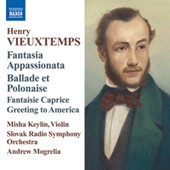Henry Vieuxtemps
Henry Vieuxtemps: the child prodigy.
Born in Verviers, Belgium, on February 17, 1820, Henry Vieuxtemps proved to be a violin prodigy from the start. At age 6 he started performing publicly, playing the 5th Rode concerto and a Fontaine Melody with orchestra.
As he was touring the Netherlands with his father at age 7, his exceptional gift was noticed by Charles de Bériot, who decided to take in charge his musical education by teaching him the violin, the piano, singing and composition.
At 11 years old, his teacher left Belgium to follow the singer Maria Malibran – who was later to become his wife. Vieuxtemps was left alone and so from then on Vieuxtemps taught himself, encouraged by his master to become his own person and not a little « de Bériot ».
Henry Vieuxtemps : the Virtuoso
From age 7, he went on touring the whole of Europe and performing concerts. This is how he began his carreer, of over 40 years, as a virtuoso.
At 14, on March 16th 1834 in Vienna, Vieuxtemps was the first to play Beethoven violin concerto after the composer’s death. The critics were unanimous. Let’s listen to the words of the Director of the Vienna Music Conservatory: « you will soon become the first violinist in Europe because you combine a strong stroke of the bow, with brilliant execution, spririt, insight and an exquisite sensitivity.. You will be the founder of a classical violin school that will be a model for all musicians. » (see handwritten letter)
At this time in Germany Vieuxtemps was accompanied by the Viennese pianist Josephine Eder who was to become his wife. Quickly after that he will be praised and acclaimed all over Europe and beyond. His biography is an endless tour of Europe, Russia, the middle East but also South America and the United States, which he toured 3 times, giving more than 120 concerts on the third tour.
His last trip was to Algeria, where he died on June 6th, 1881, at the house of his son-in-law, Edouard Landowski.
Joséphine Eder.
Joséphine is a talented Viennese pianist, born on December 3rd, 1815, and died on June 19th, 1867. She was a student of Carl Czerny and started a brilliant soloist career by touring Germany at age 13. During this trip she played with Clara Wieck, Schumann’s future wife. In 1833, Josephine finally met Vieuxtemps in Stuttgart where they performed together at a concert. They also got together in 1843 for a tour in the USA and were married the next year. From then on Joséphine became his faithful accompanist, familiar with all of his work.
« A secondary role that she fulfills perfectly as a good-hearted woman and as a great musician » says Vieuxtemps (in his handwritten autobiography).
Henry and Josephine had 2 children, Julie and Maximilien, both born in St Petersburg. Their respective descendants are the Landowsky and the Vieuxtemps families. These two families feature numerous artists and musicians: Paul Landowski (sculptor), Marcel Landowski (composer and minister of state for music), Jeanine Vieuxtemps (pianist), Manon Landowski (musician and actress ), Agnès Briolle Vieuxtemps (pianist), Marc Landowski (architect), Antoine Landowski (cellist) etc…
Henry Vieuxtemps :
composer and pedagogue
While he was touring the world, by train or steam boat, the virtuoso Henry Vieuxtemps kept writing pieces for the violin and orchestra as well as pieces of chamber music, very often with a high degree of virtuosity. He studied harmony with Sechter in Vienne in 1833/34, then composition with Raicha in Paris in 1835/36. From 1836 onwards (age 16) he performed his own compositions.
His 4th and 5th violin concertos were acclaimed by musicians and the public as veritable masterpieces. His repertoire includes about a hundred works, some of which have never been played.
As an instructor, Vieuxtemps taught the violin in St Petersburg at the music school for 6 years. He was the solo violinist of Tsar Nicolas and violinist at the imperial theaters. He had an immense influence on the practice of the violin in Russia. He was often considered a star in the country of the Tsar.
Later Vieuxtemps taught at the Bruxelles Conservatory of Music for 2 years, where among his students were Eugène Ysaÿe and Jenö Hubay.
The Ballade and Polonaise of Vieuxtemps would be one of the favorite tunes of Ysaÿe. Vieuxtemps’style, combining extraordinarily precise virtuosity with musicality, will endure. Vieuxtemps along with Charles de Bériot are seen as the founders of the ‘Franco-Belge’ school of violin, creating a new art form that would complement the work of Paganini.
An international Henry Vieuxtemps Violin Competition was held in Verviers for many years with prestigious violinist laureats such as: A. Dubois, H. Clokers, C. Van Neste, A. Grumiaux, M. Debot, G. Octors, C. R. Quatacker, H.E. Koch, Ch. Jongen, M. Fujikawa, J. Snow, E. Melon, Pei Pei Zhu, T. Samouïl, Lei Wang, H. Avanesyan.
Henry Vieuxtemps: his passion for violins
All his life, Henry Vieuxtemps was looking for high quality instruments.
He was acquainted with Vuillaume and recommended him to others, comparing his varnish to that of Stradivarius. « Vuillaume is the only artist, don’t give your violin to anybody else, only he is able to fix your violin », he said to Prince Youssoupov, in a letter dated March 24th, 1855. (Refer to the BN- Bibliothèque Nationale ).
Vieuxtemps played the violins of the greatest Luthiers: Stradivarius, Guarnerius Del Gesù , Maggini, Amati, Vuillaume. He owned fifteen in total. Many of them were given to him by Russian nobility as a sign of recognition. However, his favorite violin was the Guarnerius Del Gesu given by the Baron Pereyra in Vienna in 1846. Yehudi Menuhin played it a lot.
As of today, some of his violins are still recognised as the best violins in the world and are played by great virtuosos.
Henry Vieuxtemps: a man of his time.
During his performances, Vieuxtemps galvanized his audience, he would enthrall the public, the critics and his peers.
Hector Berlioz perfectly expressed the way Vieuxtemps’s work was greeted with unanimous praise:
« Mister Vieuxtemps is a prodigious violinist in the strictest sense of the word. He does things I have never heard done by any other before. He posits frightening dangers to the listener, but he stays calm and unshaken, confident that he will succeed . Had Vieuxtemps not been recognised as such a great virtuoso, he would be acclaimed as a great composer! The future will do justice to his work of rare beauty, informed order, unwavering presence, majesty and impeccable taste. »
Robert Schuman also marvelled at his playing in Leipzig: « Just like a fragrance bewitches us, his playing is mesmerizing. We remain unwittingly captivated as if wrapped in a magical circle ».
Paganini himself exclaimed after having heard him play: « This little boy will become a great man! »
Eugène Ysaÿe admired his master’s work as: «an endless source of precious teaching. His work has the power to reach the highest artistic joys by guiding the hand of the violinist towards a previously unknown perfection. »
Victor Hugo, a great admirer, greeted the artist in these words: «I took such pleasure in applauding today what everyone will admire tomorrow».
Henry Vieuxtemps: a man of our time.
Still today Henry Vieuxtemps keeps moving us.
Julie Depardieu shares with some humor her enthusiasm for the composer at the Saskia de Ville radio show on France Musique.
Anne Akiko-Meyer plays Vieuxtemps’favorite violin, a Guarnerius Del Gesu also called « le Vieuxtemps ». She exclaimed while seeing the picture of Vieuxtemps’ funeral: « He must have been the greatest Rock star of his time! »
Vieuxtemps’ funeral.
Translation of the ashes in Verviers on August 28, 1881.
Ysaÿe follows the hearse, holding his master’s Guarnerius del Gesu.
Vieuxtemps: the life of a nomadic artist who performed all over the world.
In Holland, in Belgium, in Germany, in Austria, in France, in Italy, in England, in Ireland, in Denmark, in Sweden where he performed for the coronation of the king Georges V, in the Baltic states, Lettony and estony, in Poland, in Ukrain, in Romania, in Greece, in the Middle East. Extensively in the Unites States, in Canada, in Mexico, in Algeria, in Turkey where he was welcomed by the sultan Abdul Mejid in Constantinople.
« This little boy will become a great man ».
«I took such pleasure in applauding today what everyone will admire tomorrow».
« The crowd was petrified at the first stroke of the bow ».
Catalog
The catalog of Vieuxtemps’ work consists of:
-61 classified pieces
-Around 20 published works without an opus number.
-Around 20 unpublished manuscripts that are digitized and stored at the Bibliothèque royale de Belgique or with the composer’s family, including an opera: « la fiancée de Messine ».
Many of the composer’s scores can be found at the la Bibliothèque Nationale de France or at the IMSLP.
Violin concertos
– Second grand concerto in F sharp minor Op. 19
– Third grand concerto in A major Op. 25
– Fourth grand concerto in D minor Op. 31
– Fifth grand concerto in A minor Op. 37
– Sixth grand concerto in G major Op. 47
– Seventh grand concerto in A minor Op. 49
– First part of an unfinished eighth grand concerto in B minor Op. 59
Cello concertos
– Second grand concerto in B minor Op. 50
Concertante works for violin and orchestra (exists also with piano reduction)
– Fantasy Caprice Op. 11
– Arpeggios – Caprice Op. 15
– Memories of Russia Op. 21
– Slavonic Fantasies Op. 27
– Introduction and Rondo Op. 28
– Fantasia Appassionata Op. 35
– Ballade and Polonaise Op. 38
– Old England- Caprice on English Airs Op. 42
–Greeting to America Op. 56
Works for viola
– Sonata for viola (or cello) and piano Op. 36
– Allegro and Scherzo for viola and piano Op. 60
– Capriccio for solo viola Op. 55
– Transcription of “Lucie” by Grétry, for viola and piano
– Transcription of “The Night” by Félicien David, for viola and piano
– Transcription on “Halka”, a romance by Moniusko, for viola and piano
– Transcription of Mozart’s clarinet quintet, for viola and piano
Chamber music
Op. 44, Op. 51, Op. 52 + Op. 17 : Memories of America
Trios :
– on “The African” by Meyerbeer, for violin, cello and piano.
– Brilliant Duet for violin cello and piano (or orchestra) Op. 39
– Edition of “The Devil’s Trill” by Tartini, for string trio.
– Arrangement of the Chaconne by Bach, for viola and cello
–Arpeggios for violin and piano, with obligato cello Op. 15
Duets for Violin and Piano :
– 7 Romances without Words Op. 7-8
– Sonata in D major Op. 12
– Concertante Duet on “The Ollone Duke” by Auber Op. 13
– Concertante Duet on “Oberon” by Weber Op. 14A– 6 Concert Studies Op. 16
– Memories of America, variations on “Yankee Doodle” Op. 17
– “Norma”, fantasy on the fourth string Op. 18
– Concertante Duet on “Don Juan” by Mozart Op. 20
– 6 “Morceaux de Salon” Op. 22
– 2 Grand Concertante Duets on “Vielka” and “The North Star” by Meyerbeer, Op. 23
– 6 Pieces on Russian Themes Op. 24
– Concertante Fantasy on “The Prophet” by Meyerbeer Op. 26
– 3 Fantasies on Verdi Operas: “I lombardi”, “Hernani” and “Luisa Miller” Op. 29
”– 6 Pieces “American Bouquet” Op. 33
– 3 Märchen, or Tales Op. 34
– 3 Pieces “Album Pages” Op. 40
– Old England : Caprice on English airs from the 16th and 17th century Op. 42
– Suite: Prelude, Minuetto, Aria, Gavotta (manuscript: orchestration) Op. 43 – Intimate voices – Melodic Thoughts Op. 45
– 36 Studies (in 36 different keys) Op. 48
– 9 Pieces: Voices from the Heart Op. 53
– 3 Brilliant Fantasies: Saltarelle, Serenade, American Pochade Op. 54
– Greeting to America Op. 56
– Impressions and Reminiscences of Poland Op. 57
– My Funeral March Op. 58
– The Butterfly: Melody on a Poem by Lamartine Ss N°
– Varied transcribed Russian songs
– Edition of “The Devil’s Trill” by Tartini – Sonata
– Concertante Fantasy on “The Huguenots” by Meyerbeer
– Duets on Hungarian Themes
– 3 Fantasies: on “Orpheus” by Glück, “The Marriage of Figaro” by Mozart, “Preciosa” by Weber
– Fantasy on “Faust” by Gounod
– Memories of Friendship -Romance
– Duet on “Paul and Virginie” by Massé
– Duet on “Raymond” by Thomas
– Duet on “Lucie” by Donizetti
Works for Solo Violin
– Amusements Op. 61
– 3 Cadenzas for Beethoven’s Violin Concerto
Opera, tunes and melodies
Orchestration: 4 woodwinds, 8 brass, 2 percussions, complete string ensemble.
Voices : women choir, men choir and 4 solists.
-Ouverture and Hymn Belge for choir and orchestra op 41.
-Five melodies for women voices and piano : SsN°
. «Melancholy» script by Eichendorf
. «You» script by Flachland
. «Decision» script by Uhland
. «The angels and the storks» script by Eichendorf
. «The miller’s death» script by Kerner
A few unpublished works
– Sixth ‘Air Varié’ for violin and piano accompaniment on ‘The Tyrolienne from William Tell’ ( 1827)
– ‘Romance Variée’ by Beethoven, for solo violin (1838)
– Variations for Orchestra on a Ludovic d’Ernst theme (1839)
– The Torchlight Procession, for wind ensemble and percussions (1848)
– Irish Airs for violin and piano accompaniment (1863)
– The First Night of May – chorus for male voices (1869)
– Venice, vocal piece for tenor and piano accompaniment (1869)
– Poem for piano (1880)
– The Onslaught- military scene, for piano four hands (1880)
– Variations for Flute and Orchestra or piano (1880)
– Unpublished opera: “The Messina Fiancée” (1865 – 1881)
Henry Vieuxtemps
Henry Vieuxtemps
Henry Vieuxtemps: the child prodigy.
Born in Verviers, Belgium, on February 17, 1820, Henry Vieuxtemps proved to be a violin prodigy from the start. At age 6 he started performing publicly, playing the 5th Rode concerto and a Fontaine Melody with orchestra.
As he was touring the Netherlands with his father at age 7, his exceptional gift was noticed by Charles de Bériot, who decided to take in charge his musical education by teaching him the violin, the piano, singing and composition.
At 11 years old, his teacher left Belgium to follow the singer Maria Malibran – who was later to become his wife. Vieuxtemps was left alone and so from then on Vieuxtemps taught himself, encouraged by his master to become his own person and not a little « de Bériot ».
Henry Vieuxtemps : the Virtuoso
From age 7, he went on touring the whole of Europe and performing concerts. This is how he began his carreer, of over 40 years, as a virtuoso.
At 14, on March 16th 1834 in Vienna, Vieuxtemps was the first to play Beethoven violin concerto after the composer’s death. The critics were unanimous. Let’s listen to the words of the Director of the Vienna Music Conservatory: « you will soon become the first violinist in Europe because you combine a strong stroke of the bow, with brilliant execution, spririt, insight and an exquisite sensitivity.. You will be the founder of a classical violin school that will be a model for all musicians. » (see handwritten letter)
At this time in Germany Vieuxtemps was accompanied by the Viennese pianist Josephine Eder who was to become his wife. Quickly after that he will be praised and acclaimed all over Europe and beyond. His biography is an endless tour of Europe, Russia, the middle East but also South America and the United States, which he toured 3 times, giving more than 120 concerts on the third tour.
His last trip was to Algeria, where he died on June 6th, 1881, at the house of his son-in-law, Edouard Landowski.
Joséphine Eder.
Joséphine is a talented Viennese pianist, born on December 3rd, 1815, and died on June 19th, 1867. She was a student of Carl Czerny and started a brilliant soloist career by touring Germany at age 13. During this trip she played with Clara Wieck, Schumann’s future wife. In 1833, Josephine finally met Vieuxtemps in Stuttgart where they performed together at a concert. They also got together in 1843 for a tour in the USA and were married the next year. From then on Joséphine became his faithful accompanist, familiar with all of his work.
« A secondary role that she fulfills perfectly as a good-hearted woman and as a great musician » says Vieuxtemps (in his handwritten autobiography).
Henry and Josephine had 2 children, Julie and Maximilien, both born in St Petersburg. Their respective descendants are the Landowsky and the Vieuxtemps families. These two families feature numerous artists and musicians: Paul Landowski (sculptor), Marcel Landowski (composer and minister of state for music), Jeanine Vieuxtemps (pianist), Manon Landowski (musician and actress ), Agnès Briolle Vieuxtemps (pianist), Marc Landowski (architect), Antoine Landowski (cellist) etc…
Henry Vieuxtemps :
composer and pedagogue
While he was touring the world, by train or steam boat, the virtuoso Henry Vieuxtemps kept writing pieces for the violin and orchestra as well as pieces of chamber music, very often with a high degree of virtuosity. He studied harmony with Sechter in Vienne in 1833/34, then composition with Raicha in Paris in 1835/36. From 1836 onwards (age 16) he performed his own compositions.
His 4th and 5th violin concertos were acclaimed by musicians and the public as veritable masterpieces. His repertoire includes about a hundred works, some of which have never been played.
As an instructor, Vieuxtemps taught the violin in St Petersburg at the music school for 6 years. He was the solo violinist of Tsar Nicolas and violinist at the imperial theaters. He had an immense influence on the practice of the violin in Russia. He was often considered a star in the country of the Tsar.
Later Vieuxtemps taught at the Bruxelles Conservatory of Music for 2 years, where among his students were Eugène Ysaÿe and Jenö Hubay.
The Ballade and Polonaise of Vieuxtemps would be one of the favorite tunes of Ysaÿe. Vieuxtemps’style, combining extraordinarily precise virtuosity with musicality, will endure. Vieuxtemps along with Charles de Bériot are seen as the founders of the ‘Franco-Belge’ school of violin, creating a new art form that would complement the work of Paganini.
An international Henry Vieuxtemps Violin Competition was held in Verviers for many years with prestigious violinist laureats such as: A. Dubois, H. Clokers, C. Van Neste, A. Grumiaux, M. Debot, G. Octors, C. R. Quatacker, H.E. Koch, Ch. Jongen, M. Fujikawa, J. Snow, E. Melon, Pei Pei Zhu, T. Samouïl, Lei Wang, H. Avanesyan.
Henry Vieuxtemps: his passion for violins
All his life, Henry Vieuxtemps was looking for high quality instruments.
He was acquainted with Vuillaume and recommended him to others, comparing his varnish to that of Stradivarius. « Vuillaume is the only artist, don’t give your violin to anybody else, only he is able to fix your violin », he said to Prince Youssoupov, in a letter dated March 24th, 1855. (Refer to the BN- Bibliothèque Nationale ).
Vieuxtemps played the violins of the greatest Luthiers: Stradivarius, Guarnerius Del Gesù , Maggini, Amati, Vuillaume. He owned fifteen in total. Many of them were given to him by Russian nobility as a sign of recognition. However, his favorite violin was the Guarnerius Del Gesu given by the Baron Pereyra in Vienna in 1846. Yehudi Menuhin played it a lot.
As of today, some of his violins are still recognised as the best violins in the world and are played by great virtuosos.
Henry Vieuxtemps: a man of his time.
During his performances, Vieuxtemps galvanized his audience, he would enthrall the public, the critics and his peers.
Hector Berlioz perfectly expressed the way Vieuxtemps’s work was greeted with unanimous praise:
« Mister Vieuxtemps is a prodigious violinist in the strictest sense of the word. He does things I have never heard done by any other before. He posits frightening dangers to the listener, but he stays calm and unshaken, confident that he will succeed . Had Vieuxtemps not been recognised as such a great virtuoso, he would be acclaimed as a great composer! The future will do justice to his work of rare beauty, informed order, unwavering presence, majesty and impeccable taste. »
Robert Schuman also marvelled at his playing in Leipzig: « Just like a fragrance bewitches us, his playing is mesmerizing. We remain unwittingly captivated as if wrapped in a magical circle ».
Paganini himself exclaimed after having heard him play: « This little boy will become a great man! »
Eugène Ysaÿe admired his master’s work as: «an endless source of precious teaching. His work has the power to reach the highest artistic joys by guiding the hand of the violinist towards a previously unknown perfection. »
Victor Hugo, a great admirer, greeted the artist in these words: «I took such pleasure in applauding today what everyone will admire tomorrow».
Henry Vieuxtemps: a man of our time.
Still today Henry Vieuxtemps keeps moving us.
Julie Depardieu shares with some humor her enthusiasm for the composer at the Saskia de Ville radio show on France Musique.
Anne Akiko-Meyer plays Vieuxtemps’favorite violin, a Guarnerius Del Gesu also called « le Vieuxtemps ». She exclaimed while seeing the picture of Vieuxtemps’ funeral: « He must have been the greatest Rock star of his time! »
Vieuxtemps’ funeral.
Translation of the ashes in Verviers on August 28, 1881.
Ysaÿe follows the hearse, holding his master’s Guarnerius del Gesu.
Vieuxtemps: the life of a nomadic artist who performed all over the world.
In Holland, in Belgium, in Germany, in Austria, in France, in Italy, in England, in Ireland, in Denmark, in Sweden where he performed for the coronation of the king Georges V, in the Baltic states, Lettony and estony, in Poland, in Ukrain, in Romania, in Greece, in the Middle East. Extensively in the Unites States, in Canada, in Mexico, in Algeria, in Turkey where he was welcomed by the sultan Abdul Mejid in Constantinople.

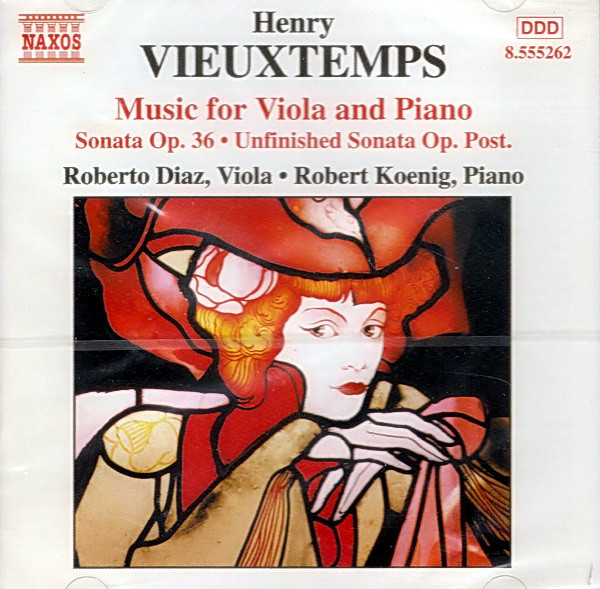



« This little boy will become a great man ».
«I took such pleasure in applauding today what everyone will admire tomorrow».
« The crowd was petrified at the first stroke of the bow ».
Catalog
The catalog of Vieuxtemps’ work consists of:
-61 classified pieces
-Around 20 published works without an opus number.
-Around 20 unpublished manuscripts that are digitized and stored at the Bibliothèque royale de Belgique or with the composer’s family, including an opera: « la fiancée de Messine ».
Many of the composer’s scores can be found at the la Bibliothèque Nationale de France or at the IMSLP.
Violin concertos
– Second grand concerto in F sharp minor Op. 19
– Third grand concerto in A major Op. 25
– Fourth grand concerto in D minor Op. 31
– Fifth grand concerto in A minor Op. 37
– Sixth grand concerto in G major Op. 47
– Seventh grand concerto in A minor Op. 49
– First part of an unfinished eighth grand concerto in B minor Op. 59
Cello concertos
– Second grand concerto in B minor Op. 50
Concertante works for violin and orchestra (exists also with piano reduction)
– Fantasy Caprice Op. 11
– Arpeggios – Caprice Op. 15
– Memories of Russia Op. 21
– Slavonic Fantasies Op. 27
– Introduction and Rondo Op. 28
– Fantasia Appassionata Op. 35
– Ballade and Polonaise Op. 38
– Old England- Caprice on English Airs Op. 42
–Greeting to America Op. 56
Works for viola
– Sonata for viola (or cello) and piano Op. 36
– Allegro and Scherzo for viola and piano Op. 60
– Capriccio for solo viola Op. 55
– Transcription of “Lucie” by Grétry, for viola and piano
– Transcription of “The Night” by Félicien David, for viola and piano
– Transcription on “Halka”, a romance by Moniusko, for viola and piano
– Transcription of Mozart’s clarinet quintet, for viola and piano
Chamber music
Op. 44, Op. 51, Op. 52 + Op. 17 : Memories of America
Trios :
– on “The African” by Meyerbeer, for violin, cello and piano.
– Brilliant Duet for violin cello and piano (or orchestra) Op. 39
– Edition of “The Devil’s Trill” by Tartini, for string trio.
– Arrangement of the Chaconne by Bach, for viola and cello
–Arpeggios for violin and piano, with obligato cello Op. 15
Duets for Violin and Piano :
– 7 Romances without Words Op. 7-8
– Sonata in D major Op. 12
– Concertante Duet on “The Ollone Duke” by Auber Op. 13
– Concertante Duet on “Oberon” by Weber Op. 14A– 6 Concert Studies Op. 16
– Memories of America, variations on “Yankee Doodle” Op. 17
– “Norma”, fantasy on the fourth string Op. 18
– Concertante Duet on “Don Juan” by Mozart Op. 20
– 6 “Morceaux de Salon” Op. 22
– 2 Grand Concertante Duets on “Vielka” and “The North Star” by Meyerbeer, Op. 23
– 6 Pieces on Russian Themes Op. 24
– Concertante Fantasy on “The Prophet” by Meyerbeer Op. 26
– 3 Fantasies on Verdi Operas: “I lombardi”, “Hernani” and “Luisa Miller” Op. 29
”– 6 Pieces “American Bouquet” Op. 33
– 3 Märchen, or Tales Op. 34
– 3 Pieces “Album Pages” Op. 40
– Old England : Caprice on English airs from the 16th and 17th century Op. 42
– Suite: Prelude, Minuetto, Aria, Gavotta (manuscript: orchestration) Op. 43 – Intimate voices – Melodic Thoughts Op. 45
– 36 Studies (in 36 different keys) Op. 48
– 9 Pieces: Voices from the Heart Op. 53
– 3 Brilliant Fantasies: Saltarelle, Serenade, American Pochade Op. 54
– Greeting to America Op. 56
– Impressions and Reminiscences of Poland Op. 57
– My Funeral March Op. 58
– The Butterfly: Melody on a Poem by Lamartine Ss N°
– Varied transcribed Russian songs
– Edition of “The Devil’s Trill” by Tartini – Sonata
– Concertante Fantasy on “The Huguenots” by Meyerbeer
– Duets on Hungarian Themes
– 3 Fantasies: on “Orpheus” by Glück, “The Marriage of Figaro” by Mozart, “Preciosa” by Weber
– Fantasy on “Faust” by Gounod
– Memories of Friendship -Romance
– Duet on “Paul and Virginie” by Massé
– Duet on “Raymond” by Thomas
– Duet on “Lucie” by Donizetti
Works for Solo Violin
– Amusements Op. 61
– 3 Cadenzas for Beethoven’s Violin Concerto
Opera, tunes and melodies
Orchestration: 4 woodwinds, 8 brass, 2 percussions, complete string ensemble.
Voices : women choir, men choir and 4 solists.
-Ouverture and Hymn Belge for choir and orchestra op 41.
-Five melodies for women voices and piano : SsN°
. «Melancholy» script by Eichendorf
. «You» script by Flachland
. «Decision» script by Uhland
. «The angels and the storks» script by Eichendorf
. «The miller’s death» script by Kerner
A few unpublished works
– Sixth ‘Air Varié’ for violin and piano accompaniment on ‘The Tyrolienne from William Tell’ ( 1827)
– ‘Romance Variée’ by Beethoven, for solo violin (1838)
– Variations for Orchestra on a Ludovic d’Ernst theme (1839)
– The Torchlight Procession, for wind ensemble and percussions (1848)
– Irish Airs for violin and piano accompaniment (1863)
– The First Night of May – chorus for male voices (1869)
– Venice, vocal piece for tenor and piano accompaniment (1869)
– Poem for piano (1880)
– The Onslaught- military scene, for piano four hands (1880)
– Variations for Flute and Orchestra or piano (1880)
– Unpublished opera: “The Messina Fiancée” (1865 – 1881)










